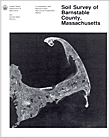The following is a map unit description from the "Soil Survey of Barnstable County, Massachusetts (Fletcher, 1993)"

MeD-Merrimac sandy loam, 15 to 25 percent slopes. This very deep, moderately steep, well drained soil is on the sides of depressions and swales on outwash plains and on hills and ridges in areas of icecontact deposits. It makes up about 0.1 percent (174 acres) of the survey area. It is mapped mainly in the Enfield-Merrimac-Carver general soil map unit. Areas are irregular in shape and range from 5 to 50 acres in size.
Typically, the surface is covered with an organic layer of loose, undecomposed pine needles, leaves, and twigs about 3 inches thick. The surface layer is very friable sandy loam about 3 inches thick. The upper 1 inch is black, and the lower 2 inches is light brownish gray. The subsoil is sandy loam about 21 inches thick. The upper 4 inches is strong brown and very friable, the next 10 inches is yellowish brown and friable, and the lower 7 inches is brownish yellow and friable. The substratum to a depth of 65 inches or more is light yellowish brown, loose coarse sand.
Included with this soil in mapping are small areas of Carver, Eastchop, Hinckley, and Plymouth soils. Also included are areas where slopes are less than 15 percent or more than 25 percent. Included soils make up about 35 percent of this unit.
Permeability is moderately rapid in the subsoil of the Merrimac soil and rapid in the substratum. Available water capacity is low. Depth to the seasonal high water table is more than 6 feet.
Most areas are used as woodland. This soil is poorly suited to cultivated crops because of the hazard of erosion, the slope, and droughtiness during periods of low rainfall.
This soil is suited to hay and pasture. The slope limits the use of equipment. The main management concern is the prevention of overgrazing, which reduces the hardiness and density of desirable plants. Proper stocking rates, timely grazing, and restricted use during wet periods help to maintain plant density and minimize surface compaction.
This soil is suited to woodland. Because of droughtiness, some seedling loss is expected. The slope limits the use of equipment. Removal or control of competing vegetation helps to obtain the best growth of newly established seedlings. The most common trees are pitch pine, white oak, scarlet oak, eastern white pine, and black oak.
The slope is a limitation if this soil is used as a site for buildings. Extensive land shaping is generally needed. Buildings and lots should be designed so that they conform to the natural slope of the land. Erosion is a severe hazard during and after construction. Planting well suited grasses as soon as possible after the surface is disturbed minimizes the erosion hazard.
This soil is limited as a site for septic tank absorption fields because of the slope and the rapid permeability in the substratum. The soil may not adequately filter the effluent. The poor filtering capacity may result in the pollution of ground water. The hazard of pollution increases with the density of housing. Installing the distribution lines on the contour or in areas that were graded during construction of the dwelling helps to overcome the slope. Precautionary measures may be necessary in some areas.